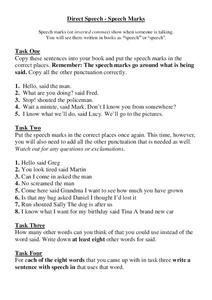Curated OER
Sorting Angles
In this sorting angles worksheet, students distinguish the differences between right, obtuse and acute angles. Students determine what type of angle thirteen angles are as shown.
Curated OER
Right Angles
In this math worksheet, students compare different shapes while identifying the right angles. They also write down the right angles seen in a classroom.
Curated OER
Right Angles
In this math worksheet, students learn to recognize a right angle. Students study the picture of the right angle and are asked to draw 3 examples. Students then find and draw 9 examples of right angles in objects around them.
Curated OER
Gougu Rule or Pythagoras' Theorem
Fifth graders explore Pythagoras' Theorem. They examine the pattern linking the length of the hypotenuse of a right angled triangle and the length of the other two sides. Students find an unknown side in right angled triangles.
Curated OER
Hey! What Is Your Angle?
Fifth graders create and classify straight, right, acute and obtuse angles. In this clever lesson, 5th graders utilize pretzel sticks to form different types of angles. Best of all, they get to eat them at the end!
Curated OER
Classifying Angles: Greater Than, Less Than, or Equal to 90 Degrees?
In this angles worksheet, students analyze four angles. For each angle, students decide if it is greater, less than, or equal to a right angle. Students check the correct box.
Curated OER
Right Angles
In this right angles instructional activity, students review various images of right angles. Students then find the angles and right angles for the given shapes and write them on the lines.
Curated OER
Cosine
In this cosine worksheet, 10th graders solve 10 different problems that include various triangles. They determine the cosine of one point in each triangle illustrated. Then, they apply the line segments given to each and solve for the...
Curated OER
Right Angles in the Classroom
In this finding right angles activity, learners look around the classroom and draw any right angles they see. Students then "tick" any right angle in 6 geometric shapes.
Curated OER
Naming Angles 2
In this naming angles worksheet, 10th graders complete 12 problems that identify and name various types of angles in figures. They name a pair of vertical angles and a linear pair in 8 of the problems. Then, students name a pair of...
Curated OER
Cube Count
In this cube counting worksheet, students solve 5 word problems that refer to the illustration of a stack of cubes. First, they determine how many cubes would be needed to make four steps, then seven and eight steps. Students also...
Curated OER
Geometry: Classifying Angles
Students measure, construct, and classify angles as acute, right, straight, and obtuse. Once they have completed an angle worksheet, students use a map of South Carolina to locate cities by constructing the aforementioned angles.
Curated OER
Math: A Geometric Neighborhood
Students, as a final project, draw a picture of their ideal neighborhood on a sunny day. In addition to the sun, their drawings include homes, trees, streets, and selected objects. Each object in their drawing has a written description...
Curated OER
Investigating the Idea of Cos
Fifth graders use cos to solve problems involving right-angled triangles. They solve equations of the form cos(++) = a, for a between -180 and 360 degrees. They state the value of cos(++) in special cases and graph y = cos(++).
Curated OER
Secrets of Lost Empires I-Colosseum
Sixth graders identify how to use pulleys to change the direction of force. Students develop ways to evaluate designs, noting that no one best design exists and that different tasks require different designs. Students designs will vary.
















